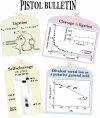Biochemical analysis of cleavage and ligation activities of the pistol ribozyme from Paenibacillus polymyxa
- PMID: 33622172
- PMCID: PMC8583172
- DOI: 10.1080/15476286.2021.1874706
Biochemical analysis of cleavage and ligation activities of the pistol ribozyme from Paenibacillus polymyxa
Abstract
Nine distinct classes of self-cleaving ribozymes are known to date, of which the pistol ribozyme class was discovered only 5 years ago. Self-cleaving ribozymes are able to cleave their own phosphodiester backbone at a specific site with rates much higher than those of spontaneous RNA degradation. Our study focuses on a bioinformatically predicted pistol ribozyme from the bacterium Paenibacillus polymyxa. We provide a biochemical characterization of this ribozyme, which includes an investigation of the effect of various metal ions on ribozyme cleavage and a kinetic analysis of ribozyme activity under increasing Mg2+ concentrations and pH. Based on the obtained results, we discuss a possible catalytic role of divalent metal ions. Moreover, we investigated the ligation activity of the P. polymyxa pistol ribozyme - an aspect that has not been previously analysed for this ribozyme class. We determined that the P. polymyxa pistol ribozyme is almost fully cleaved at equilibrium with the ligation rate constant being nearly 30-fold lower than the cleavage rate constant. In summary, we have characterized an additional representative of this recently discovered ribozyme class isolated from P. polymyxa. We expect that our biochemical characterization of a pistol representative in a cultivatable, genetically tractable organism will support our future investigation of the biological roles of this ribozyme class in bacteria.
Keywords: Paenibacillus polymyxa ATCC 842; RNA World; RNA catalysis; apparent first-order rate constant; general acid-base catalysis; internal phosphoester transfer; nucleolytic ribozymes; pKa of hydrated metal ion; self-cleaving ribozymes; transesterification.
Conflict of interest statement
No potential conflict of interest was reported by the authors.
The authors report no conflict of interest.
Figures





Similar articles
-
Biochemical analysis of pistol self-cleaving ribozymes.RNA. 2015 Nov;21(11):1852-8. doi: 10.1261/rna.052514.115. Epub 2015 Sep 18. RNA. 2015. PMID: 26385507 Free PMC article.
-
Pistol ribozyme adopts a pseudoknot fold facilitating site-specific in-line cleavage.Nat Chem Biol. 2016 Sep;12(9):702-8. doi: 10.1038/nchembio.2125. Epub 2016 Jul 11. Nat Chem Biol. 2016. PMID: 27398999 Free PMC article.
-
Comparison of the Structures and Mechanisms of the Pistol and Hammerhead Ribozymes.J Am Chem Soc. 2019 May 15;141(19):7865-7875. doi: 10.1021/jacs.9b02141. Epub 2019 May 2. J Am Chem Soc. 2019. PMID: 31017785 Free PMC article.
-
Structural and Biochemical Properties of Novel Self-Cleaving Ribozymes.Molecules. 2017 Apr 24;22(4):678. doi: 10.3390/molecules22040678. Molecules. 2017. PMID: 28441772 Free PMC article. Review.
-
Structure-based mechanistic insights into catalysis by small self-cleaving ribozymes.Curr Opin Chem Biol. 2017 Dec;41:71-83. doi: 10.1016/j.cbpa.2017.09.017. Epub 2017 Nov 3. Curr Opin Chem Biol. 2017. PMID: 29107885 Free PMC article. Review.
Cited by
-
Self-cleaving ribozymes: substrate specificity and synthetic biology applications.RSC Chem Biol. 2021 Jul 2;2(5):1370-1383. doi: 10.1039/d0cb00207k. eCollection 2021 Oct 7. RSC Chem Biol. 2021. PMID: 34704043 Free PMC article. Review.
-
cyPhyRNA-seq: a genome-scale RNA-seq method to detect active self-cleaving ribozymes by capturing RNAs with 2',3' cyclic phosphates and 5' hydroxyl ends.RNA Biol. 2021 Nov 12;18(sup2):818-831. doi: 10.1080/15476286.2021.1999105. Epub 2021 Dec 14. RNA Biol. 2021. PMID: 34906034 Free PMC article.
-
Who stole the proton? Suspect general base guanine found with a smoking gun in the pistol ribozyme.Org Biomol Chem. 2022 Aug 10;20(31):6219-6230. doi: 10.1039/d2ob00234e. Org Biomol Chem. 2022. PMID: 35452066 Free PMC article.
-
Scaling Catalytic Contributions of Small Self-Cleaving Ribozymes.Angew Chem Int Ed Engl. 2022 Oct 10;61(41):e202207590. doi: 10.1002/anie.202207590. Epub 2022 Sep 2. Angew Chem Int Ed Engl. 2022. PMID: 35982640 Free PMC article.
-
Rapid Kinetics of Pistol Ribozyme: Insights into Limits to RNA Catalysis.Biochemistry. 2023 Jul 4;62(13):2079-2092. doi: 10.1021/acs.biochem.3c00160. Epub 2023 Jun 9. Biochemistry. 2023. PMID: 37294744 Free PMC article.
References
-
- Woese C. 1967. The genetic code: the molecular basis for genetic expression. New York: Harper & Row. Available online at: http://worldcatlibraries.org/wcpa/oclc/293697
-
- Orgel LE. Evolution of the genetic apparatus. J Mol Biol. 1968;38(3):381–393. - PubMed
-
- Crick FHC. The origin of the genetic code. J Mol Biol. 1968;38(3):367–379. - PubMed
-
- Kruger K, Grabowski PJ, Zaug AJ, et al. Self-splicing RNA: autoexcision and autocyclization of the ribosomal RNA intervening sequence of tetrahymena. Cell. 1982;31(1):147–157. - PubMed
Publication types
MeSH terms
Substances
LinkOut - more resources
Full Text Sources
Other Literature Sources
Molecular Biology Databases
